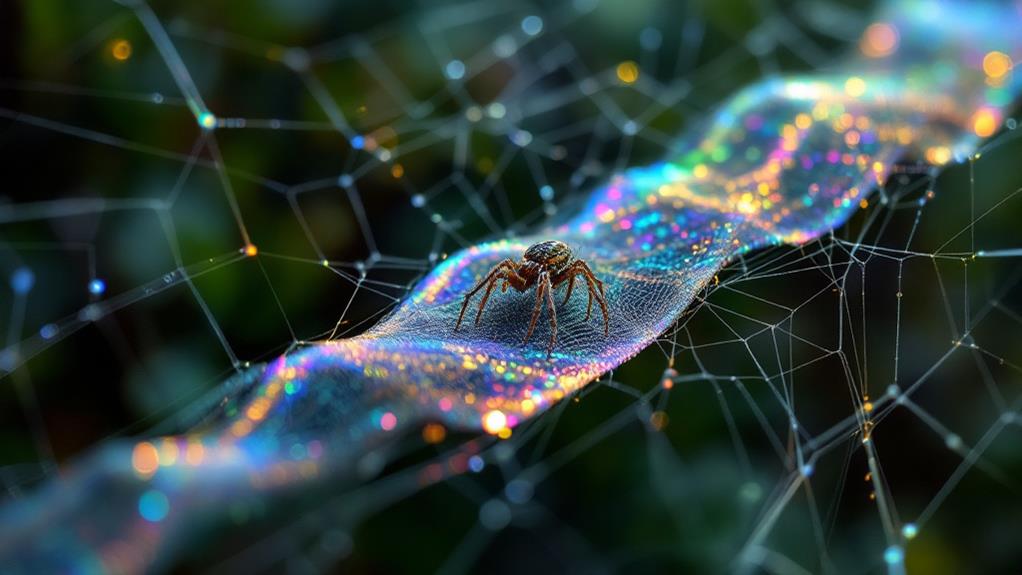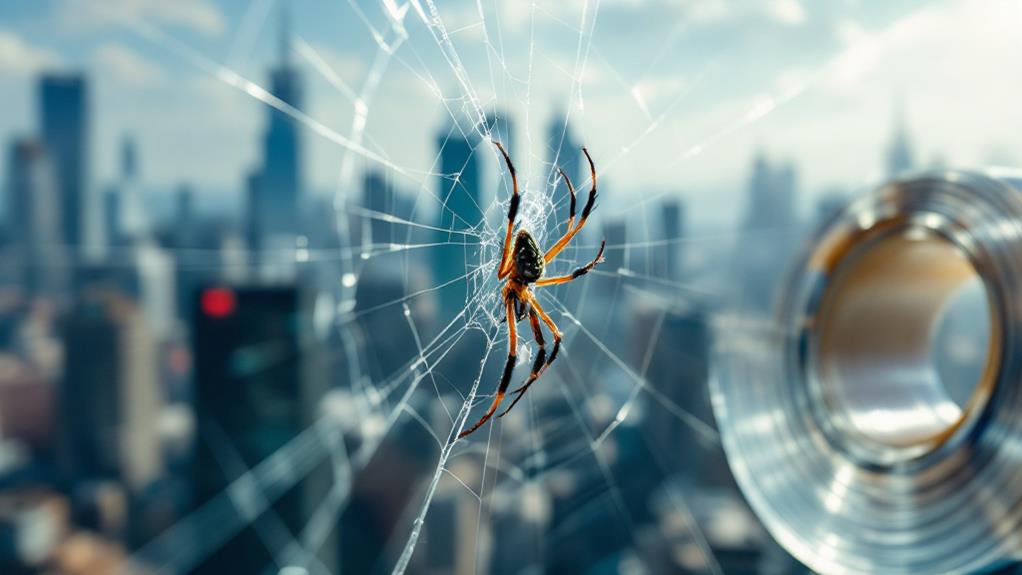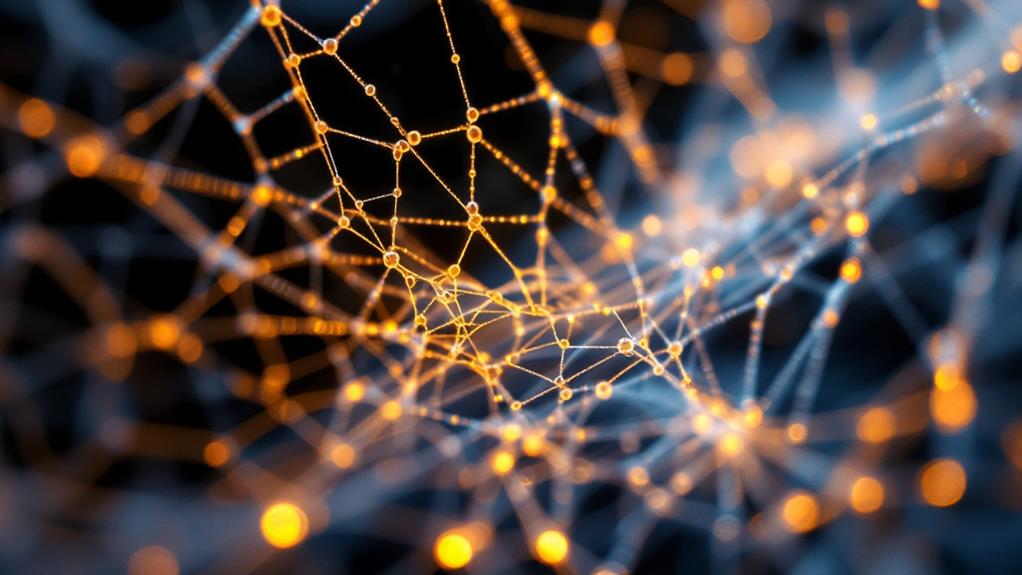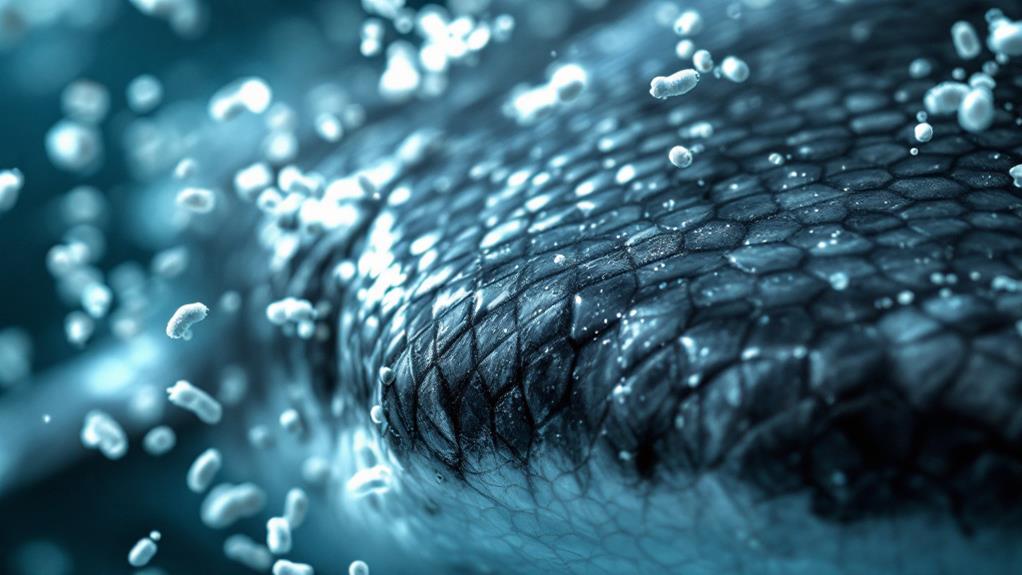The Amazing Origins of Spider Silk Tape: Stronger Than Steel, Inspired by Nature

Spider silk, nature's strongest material, has inspired scientists to create an adhesive tape that's stronger than steel. You'll be amazed to learn how researchers have uncovered the molecular secrets of spider silk's exceptional strength and elasticity. By replicating its complex protein structures, they've engineered a synthetic version that combines incredible strength with flexibility. This revolutionary tape has potential applications across industries, from medicine to aerospace. While challenges in large-scale production remain, the future looks bright for spider silk-inspired technologies. Explore how this remarkable innovation could alter everything from wound closures to lightweight materials in construction and beyond.
The Marvel of Spider Silk
Spider silk is one of nature's most astounding materials. You've likely marveled at intricate web patterns glistening in the morning dew, but the true wonder lies in the silk itself. This exceptional substance boasts strength-to-weight ratios that surpass steel, while maintaining incredible elasticity and flexibility.
The silk production process in spiders is a masterpiece of biological engineering. Specialized glands in the spider's abdomen produce liquid protein solutions, which are then extruded through tiny openings called spinnerets. As the liquid passes through these spinnerets, it's exposed to mechanical stress and chemical changes, causing the proteins to align and form strong, microscopic fibers.
What's truly astonishing is the variety of silk types a single spider can produce. Some silks are sticky for catching prey, while others are non-sticky for the spider to walk on. The dragline silk used for web frames and lifelines is particularly impressive, combining strength and toughness in a way that's inspired countless biomimetic innovations.
Scientists and engineers continue to study spider silk, seeking to divulge its secrets and develop synthetic versions for various applications, from medical sutures to bulletproof vests.
Unraveling Nature's Strongest Material
Researchers have been delving into the mysteries of spider silk for decades, aiming to reveal its secrets. You might wonder why this material has captured so much scientific attention. The answer lies in its exceptional properties: spider silk is five times stronger than steel by weight and more elastic than rubber.
To unravel nature's strongest material, scientists have focused on understanding its molecular composition. They've discovered that spider silk consists of long protein chains arranged in a complex structure. These proteins, primarily fibroin, give the silk its extraordinary strength and flexibility.
You'd be amazed to learn about the intricate silk production pathways within a spider's body. Specialized glands produce liquid silk proteins, which are then pushed through narrow ducts. As the silk travels through these ducts, it undergoes a process called "spinning," where the proteins align and form strong hydrogen bonds.
From Web to Wonder

While nature has long held the secret to spider silk's extraordinary properties, scientists have recently made pioneering advancements in tapping into its potential. You'll be amazed at how researchers have transformed these web wonders into practical applications. By studying the molecular structure of spider silk, they've unlocked its secrets and developed synthetic versions that mimic its strength and flexibility.
The expedition from silk splendor to human innovation has been remarkable. Scientists have engineered bacteria to produce spider silk proteins, allowing for large-scale production without relying on spiders. This breakthrough has paved the way for creating spider silk-inspired materials with diverse applications.
You'll find these advancements in various fields, from medicine to aerospace. Surgeons are using spider silk-based sutures that dissolve naturally in the body, while engineers are developing lightweight, super-strong materials for aircraft and body armor. The most exciting development is the creation of spider silk tape, which combines the material's incredible strength with adhesive properties. This innovation promises to revolutionize industries ranging from construction to electronics, offering a sustainable alternative to traditional adhesives and fasteners.
Scientists Behind the Innovation
Brilliant minds from diverse scientific backgrounds have converged to plunge into the secrets of spider silk. You'll find pioneering researchers from fields like biomaterials, nanotechnology, and polymer science working tirelessly to unlock nature's potential. These innovative minds have dedicated years to understanding the complex structure and properties of spider silk, pushing the boundaries of what's possible in material science.
You might be surprised to learn that it's not just biologists involved in this groundbreaking work. Engineers, chemists, and physicists have all played crucial roles in developing spider silk-inspired materials. They've used advanced techniques like genetic engineering, molecular modeling, and cutting-edge microscopy to unravel the mysteries of these incredible fibers.
The scientists behind this innovation have faced numerous challenges, from replicating the precise protein structures to scaling up production for practical applications. But their persistence and creativity have paid off, resulting in the development of spider silk tape that's more robust than steel. Their work exemplifies the power of interdisciplinary collaboration and nature-inspired design, paving the way for revolutionary materials that could transform industries from medicine to aerospace.
Molecular Secrets Revealed

The molecular structure of spider silk holds the key to its extraordinary properties. When you examine it closely, you'll find that spider silk is composed of long protein chains called fibroins. These chains are arranged in a unique way that gives the silk its incredible strength and elasticity.
At the molecular level, spider silk consists of crystalline regions interspersed with amorphous areas. The crystalline sections provide strength, while the amorphous regions allow for flexibility. This combination is what makes spider silk so tough and resistant to breaking.
The underlying chemistry of spider silk is equally fascinating. The proteins in spider silk are rich in amino acids like glycine and alanine, which form strong hydrogen bonds. These bonds contribute to the silk's tensile strength, making it stronger than steel by weight.
You'll also find that spider silk contains beta-sheet structures, which are responsible for its ability to absorb energy without breaking. This molecular arrangement allows the silk to stretch extensively before failing, making it an ideal material for various applications, from medical sutures to bulletproof vests.
Engineering the Perfect Adhesive
Scientists and engineers have long sought to exploit the incredible properties of spider silk for adhesive applications. They've focused on replicating the material properties that make spider silk so unique, including its strength, elasticity, and ability to adhere to various surfaces.
To engineer the perfect adhesive, researchers have studied the molecular structure of spider silk proteins and how they interact with different substrates. They've uncovered that the combination of rigid and flexible regions in the protein molecules contributes to the silk's phenomenal adhesive performance. By manipulating these structural elements, scientists have developed synthetic spider silk-inspired adhesives that can outshine traditional glues in many applications.
One key challenge has been balancing strength and flexibility in the engineered adhesives. Too much rigidity can lead to brittle bonds, while excessive flexibility may compromise overall strength. Through careful tweaking of the protein composition and production methods, researchers have created adhesives that closely mimic the properties of natural spider silk. These advanced materials show promise for use in medical applications, such as wound closures and tissue engineering, as well as in industrial settings where high-performance, environmentally friendly adhesives are needed.
Applications Across Industries

Spider silk-inspired adhesives are revolutionizing industries across the board. You'll find these innovative tapes making their way into fields you might not expect. In the medical sector, they're being used for wound closures and drug delivery systems, offering a gentler alternative to traditional sutures and bandages. Surgeons are exploring their potential for internal tissue repair, taking advantage of their biocompatibility and strength.
In aerospace and automotive industries, you'll see these adhesives replacing traditional fasteners, reducing weight and improving fuel efficiency. They're also finding applications in electronics, where their conductivity and flexibility make them ideal for flexible screens and wearable devices.
The construction industry is embracing spider silk-inspired tapes for their durability and weather resistance. You'll notice them being used in everything from sealing joints to reinforcing structures.
What's more, these adhesives are facilitating alternative manufacturing processes and eco-friendly production methods. They're biodegradable and can be produced without harmful chemicals, aligning with the growing demand for sustainable solutions across all industries. As research continues, you can expect to see even more innovative applications emerge.
Challenges in Development
While spider silk-inspired adhesives show immense promise, their development hasn't been without obstacles. You'll find that researchers face significant manufacturing challenges when trying to replicate the complex structure of spider silk on a large scale.
One of the main hurdles you'll encounter is the difficulty in producing synthetic spider silk proteins that match the strength and elasticity of natural silk. The process requires precise control over protein folding and assembly, which is hard to achieve in industrial settings. You'll also notice that maintaining consistency in the final product across batches can be problematic.
Another issue you'll face is the commercial viability of spider silk-inspired adhesives. The production costs are currently high, making it challenging to compete with existing adhesive technologies. You'll need to find ways to streamline the manufacturing process and reduce expenses to make these products viable for widespread use.
Additionally, you'll have to address environmental concerns, as some synthetic production methods may not be eco-friendly. Overcoming these pivotal challenges will be essential for bringing spider silk-inspired adhesives from the lab to the marketplace.
Future of Spider Silk Technology

Innovation in spider silk technology promises a revolutionary future across multiple industries. You'll soon see spider silk-based products in healthcare, where its biocompatibility and strength make it ideal for sutures, wound dressings, and artificial tendons. In aerospace and automotive sectors, lightweight spider silk composites could drastically reduce fuel consumption and enhance vehicle performance.
Emerging manufacturing techniques are establishing the way for scalable production methods, addressing previous limitations in mass production. You can expect to see advancements in genetic engineering of silkworms and bacteria to produce spider silk proteins more efficiently. 3D printing technologies may also incorporate spider silk materials, enabling the creation of complex, customized structures with unparalleled strength-to-weight ratios.
As research progresses, you'll witness the development of smart textiles infused with spider silk properties, offering enhanced durability and functionality in clothing and protective gear. The construction industry might adopt spider silk-reinforced materials for stronger, more resilient buildings. With ongoing improvements in production efficiency and material engineering, spider silk technology is set to transform numerous aspects of your daily life in the coming years.



